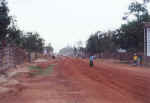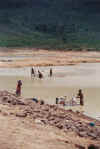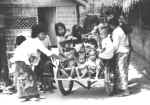Thai / Cambodia Border Refugee
Camps 1975-1999
Information and
Documentation Website
|
|
Khao I Dang / Site II
/ 2 / Site B
/ Site 8 / Sok San / Site K / O'Trao
|
Photos, Maps,
Statistics, People, Places and Events
|
Home - Border Camps
- NGOs - UNBRO - Border
History - Repatriation - Documents
- Maps
- Glossary - Links
- About - Site Map - Contact
Site II / Site 2 / Site Two
Site
II / Site 2, the largest
of the Cambodian refugee camps on the Thai / Cambodian border was a KPNLF (Khmer
Peoples' National Liberation Front) administered Khmer
refugee camp located 70Km north of Aranyaprathet on the Thai / Cambodian border, the closest
town was Taphraya, which was home for many NGO workers and the entry point to the
KPNLF "Liberated Zones".
|

(Photos
by Richard Rowat) |
|
Site II
- Sub-Camps Site
II consisted of many of the old KPNLF camps which had been overrun by
Vietnamese offensives and the civilian populations had been brought together in one
place. Each sub-camp had its own Khmer administration and these spent much
of their time squabbling amongst themselves and making sure they got
their own fair share but little time looking after their people. NGO staff
were not permitted to remain in the camps after 4PM. At night the camps
could take on a more military air with tanks and other military vehicles occasionally
rumbling through the streets. |
Site II / Site 2 Sub-Camps
|
Site II / 2 - North
Ampil
Dang Rek
Nong Chan /
Nam Yuen
Sanro
|
Site II / 2 South
Nong Samet / Rithysen
O'Bok |
|
1989 Border Khmer
Demographic Survey - includes camp descriptions and populations |
Background
See
- 1989
Border Khmer Demographic Survey - includes camp descriptions
Site II
/ 2 was big,
one could easily become lost wandering around it. It was so big that the Thais
could not control it as they did the other camps. This was good and bad, it
allowed more personal freedom and presented more opportunities but on the down
side there was less law and order, justice often took the form of revenge with a
gun or a grenade. There were all types of businesses from restaurants where you
could get a fresh lobster and a beer to machine shops that would fabricate parts
for our printing presses, from tailors that would custom make a suit or uniform
to jewelers designing and fabricating unique pieces. On a darker side you could also buy
antiquities stolen from archeological sites such as Angkor, this was a favoured
activity between resistance commanders and Thais.
Site
II developed a strong infrastructure mostly with the help of UNBRO and the NGOs.
There were two universities with varied programmes. I employed an woman
accountant who was very competent. At first there was some resistance to her but
she soon fit in and became part of our team. There was a bi-weekly Khmer
language newspaper distributed to all of the UNBRO border camps, as time passed
this became quite an independent publication sometimes annoying powerful
individuals in the camps and coming under threat. Heng Bo was the editor and
quite a brave man considering the threats that came his way. Site 2 had a Khmer
judicial system with a court and judge, again as time passed this became an independent
and effective part of the infrastructure, it came to judge serious cases
involving corruption and violence; there was a prison system to support
it.
Buddhism
was integral part of life in the camps. Site II came to have the largest Khmer
temple in the world at the time (Wat Prasatsiri located in Rithysen camp Site 2) with more than 200 monks. The
abbot was the Venerable Pin Sem who not only led his monks but also acted as
intermediary and conciliator when there was strife between sub-camps and other
situations that could lead to conflict and violence. The Venerable Pin Sem's
efforts at reviving traditional Khmer art forms is renowned and continues to
this day in Siem Reap. Also little known was that he collected and
preserved ancient ceramics, wall paintings and wooden Buddhas. Some of these he
acquired from traders who otherwise would have sold them to Thais in Site II.
This collection is now housed and displayed at Wat Bo in Siem Rieap.
Programs
UNBRO was
responsible for coordination of all matters relating to the provision of aid and
assistance in the camps. They were directly responsible for food and water. All
other support was provided by NGOs, either funded by the UN or privately.
ARC - Medical
COERR
(Catholic Office for Emergency and Refugee Relief)- Education, Dombosco
Vocational School and Social Programs, Unaccompanied Minors and other shelters
CONCERN - Sanitation, Construction,
Site Maintenance
COR
(Christian Out Reach) - MCH (Mother Child Health)
HI
(Handicap International) - Hospital for Land Mine Amputees and Rehabilitation
ICRC
(International Committee of the Red Cross) - Family Reunification
IRC
(International Rescue Committee) - Special Education and
Printing
SIPAR -
French as a Second Language
YWAM
(Youth With A Mission)
Site
II / 2 - Population
1989
- 145,000 (Border Khmer Report)
1991 - 198,582
Home - Border Camps
- NGOs - UNBRO - Border
History - Repatriation - Documents
- Maps
- Glossary - Links
- About - Site Map - Contact
Web Services
by

Send mail to with questions or comments about this website.
Last modified: 19/01/14
All photos by Richard
Rowat unless otherwise specified


















